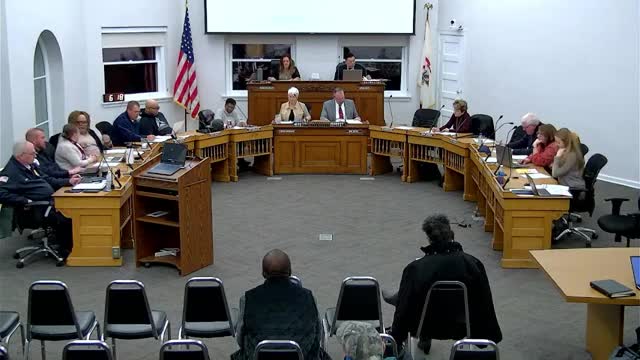Freeport outlines $45M phase for wastewater upgrades as new NPDES permit tightens phosphorus and PFAS testing
November 11, 2025 | Freeport, Stephenson County, Illinois
This article was created by AI summarizing key points discussed. AI makes mistakes, so for full details and context, please refer to the video of the full meeting. Please report any errors so we can fix them. Report an error »

City staff and consultants detailed a multi‑phase plan to upgrade Freeport’s wastewater treatment plant after the Illinois EPA issued a National Pollutant Discharge Elimination System (NPDES) permit that tightens phosphorus limits and adds PFAS monitoring requirements.
Manager Boyer and engineering staff outlined the three‑phase program: Phase 1 (currently under construction) is an approximately $60 million upgrade that includes headworks, UV disinfection and a new lab building; Phase 2 — described as sludge handling and digestion work — is estimated at roughly $45 million and is required to begin in 2027 to meet permit deadlines; Phase 3 (primary filtration upgrades) is currently estimated at about $25 million. The presenters said the project sequence was restructured to increase the chance of receiving forgivable funds from state programs.
Staff cited specific permit requirements: "it is required that phosphorus will be down to 0.5 milligrams per liter by 01/01/2030," and noted the city’s current phosphorus discharges are about 2 to 3 milligrams per liter. Presenters explained that the chemical phosphorus removal approach chosen for the site will add substantial solids to the waste stream and likely more than double the facility’s current sludge handling needs, increasing press operations from roughly four days per week toward six and requiring expanded storage and new digesters.
The permit also includes new PFAS testing obligations. Staff said the city will perform sampling in a cost‑share arrangement and that an initial PFAS testing work order is $41,000. Design services for the Phase 2 project were estimated at just under $3,000,000 for inclusion with a roughly $45,000,000 construction estimate.
On funding, staff said Freeport intends to pursue a state revolving fund (SRF) loan and indicated projects can qualify for a maximum forgiveness amount of about $5,000,000 per project. "We are confident, can't guarantee anything, but we're confident that we'll qualify for 5,000,000 in forgiveness on that," a presenter said, but also warned that rate increases and local utility user charges would likely be needed to cover remaining costs if additional grants are not secured.
Council questions focused on the costs of PFAS testing, the design fee estimate and the anticipated share of funding the city might need to cover through rates. Staff noted the plant’s tight footprint (solar panels bordering the site), the age and deterioration of existing digesters and the necessity of moving forward to avoid daily permit fines for noncompliance after 2030.
Next steps: staff will bring formal engineering agreements and work orders (including the PFAS sampling work order and Phase 2 design work) forward for council action; funding strategy discussions and grant applications will continue.
Manager Boyer and engineering staff outlined the three‑phase program: Phase 1 (currently under construction) is an approximately $60 million upgrade that includes headworks, UV disinfection and a new lab building; Phase 2 — described as sludge handling and digestion work — is estimated at roughly $45 million and is required to begin in 2027 to meet permit deadlines; Phase 3 (primary filtration upgrades) is currently estimated at about $25 million. The presenters said the project sequence was restructured to increase the chance of receiving forgivable funds from state programs.
Staff cited specific permit requirements: "it is required that phosphorus will be down to 0.5 milligrams per liter by 01/01/2030," and noted the city’s current phosphorus discharges are about 2 to 3 milligrams per liter. Presenters explained that the chemical phosphorus removal approach chosen for the site will add substantial solids to the waste stream and likely more than double the facility’s current sludge handling needs, increasing press operations from roughly four days per week toward six and requiring expanded storage and new digesters.
The permit also includes new PFAS testing obligations. Staff said the city will perform sampling in a cost‑share arrangement and that an initial PFAS testing work order is $41,000. Design services for the Phase 2 project were estimated at just under $3,000,000 for inclusion with a roughly $45,000,000 construction estimate.
On funding, staff said Freeport intends to pursue a state revolving fund (SRF) loan and indicated projects can qualify for a maximum forgiveness amount of about $5,000,000 per project. "We are confident, can't guarantee anything, but we're confident that we'll qualify for 5,000,000 in forgiveness on that," a presenter said, but also warned that rate increases and local utility user charges would likely be needed to cover remaining costs if additional grants are not secured.
Council questions focused on the costs of PFAS testing, the design fee estimate and the anticipated share of funding the city might need to cover through rates. Staff noted the plant’s tight footprint (solar panels bordering the site), the age and deterioration of existing digesters and the necessity of moving forward to avoid daily permit fines for noncompliance after 2030.
Next steps: staff will bring formal engineering agreements and work orders (including the PFAS sampling work order and Phase 2 design work) forward for council action; funding strategy discussions and grant applications will continue.
View full meeting
This article is based on a recent meeting—watch the full video and explore the complete transcript for deeper insights into the discussion.
View full meeting
